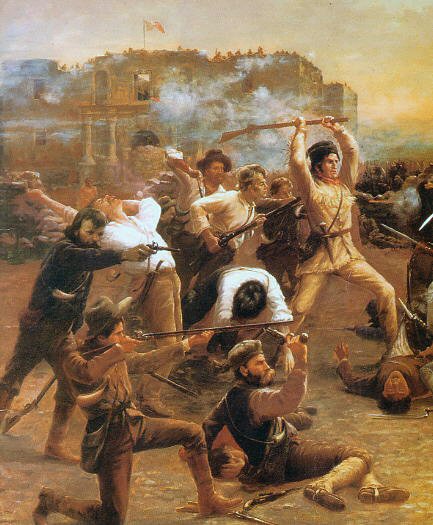|
OLDEST HERO AT THE ALAMO: GORDON JENNINGS OF CONNECTICUT Nicholas
E. Hollis Gordon C. Jennings was born in May 1782 in Windham, Connecticut, the eldest son of Joseph and Ruth (Cartwright) Jennings. Joseph had served in the Continental Army during the Revolutionary War and traced his line to the Joshua Jennings’ family, which first settled in Hartford in the 1630s. A farmer, Gordon was among the first pioneers to settle in Troy, Missouri (outside St. Louis) in the early 1820s. In 1833, he and a brother moved with their families to Bastrop, Texas (near present-day Austin). Later, encouraged by the promise of land grant compensation, Gordon enlisted in the Texas militia on July 25, 1835 under Capt. R.M. Williamson in the command of Col. John H. Moore. On December 13, 1835, Gordon re-enlisted, this time under Col. William B. Travis. As Texas colonists became increasingly discontented with the Mexican Government they were obligated to serve, Travis moved his regiment to the Alamo mission in January 1836 and awaited reinforcements. Gordon Jennings, a corporal, was probably manning the artillery positions when Santa Anna’s army arrived on February 23 and surrounded the crumbling church and outer lying buildings. After a thirteen-day siege, on March 6 at daybreak, 4000 Mexican infantry and dragoons mounted their final assault. They attacked in three columns, simultaneously hitting a breach in the north wall, the chapel and, a third scaling the west barrier. Hurled back twice by furious artillery and rifle fire, the Mexicans finally stormed the garrison with ladders and overran those 189 Texas militiamen. Room by room “was carried at the point of a bayonet. When the brutal hand-to-hand fighting subsided ninety minutes later, the gallant defenders lay dead. Legendary frontiersman and erstwhile populist congressman, David Crockett and six others, cornered in the church, were the last killed. Santa Anna ordered all the bodies burned, but his commanders were stunned by the ferocity of the Texans’ resistance. The Mexicans suffered more than 1,600 casualties in the assault – the flower of Santa Anna’s army.
In a cruel irony, Charles B. Jennings, Gordon’s brother (or cousin) was killed at the Goliad massacre later that month. Alamo and Goliad became rallying cries for Texas freedom, and years later the Jennings family heirs received 1,280 acres for each hero – reflecting their service and ultimate sacrifice. Gordon’s son, Samuel Jennings (1828-1881), became a prosperous stockman in the cattle business – and Gordon’s daughter, Catherine (1826-1911), became a legend in her own right. As a ten-year-old, Catherine had ridden bareback many miles to warn her neighbors of the advancing Mexican army – and thus, “the Ride of Katy Jennings” became regarded for Texas as a kind of Paul Revere’s ride. Additional Reading “The Alamo Heroes and Their Revolutionary Ancestors,” San Antonio, Daughters of the American Revolution (1976). “The Alamo” by Mary Ann Noonan Guerra (1983). “Fall of the Alamo and Massacre of Travis and his Brave Associates” by Frances Antonio Ruiz, Texas Almanac (Waco) 1857-58. David Crockett: The Man and the Legend. James Shackford, University of Nebraska Press, 1956.
Jennings Heritage
Project "Leadership Education and Character Development Through Historical Scholarship" |
